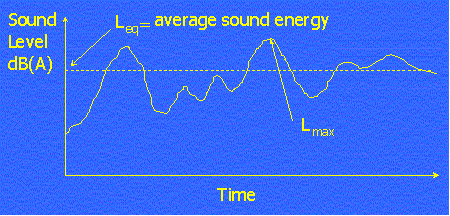Glossary
Explanation of noise terms
Noise is unwanted sound. Sound is any variation in atmospheric pressure that can be detected by the ear. For the ear to detect pressure variations as sounds the variations must occur 20 times per second. Noise is measured using an instrument that is known as a sound level meter. The sound level meter displays what is known as a sound pressure level. Although the sound is actually a variation in pressure that the ear can detect it is simply too messy to measure the sound in terms of pressure because the ear can actually respond to a huge range of pressure variations and the numbers involved would become too unwieldy. To overcome this problem we use the decibel (dB). The decibel is not an absolute unit of measurement; it is a logarithmic ratio between a measured quantity and an agreed reference level. The use of a logarithmic scale is actually very useful because the ear reacts to a logarithmic change in level, which corresponds to the decibel scale where 1dB is the same relative change everywhere on the scale.
The sound level meter is an instrument designed to give objective, reproducible measurements of sound pressure level. There are many different sound measuring systems available; however, basically each system consists of a microphone, a processing unit and a display unit.
Sound is made up of different frequencies and because the ear is more sensitive to some frequencies than to others the sound level meter can apply a weighting to simulate the response of the ear. This is called the “A” weighting and it is commonly used in environmental noise measurements.
Because sound varies with time it is necessary to determine suitable metrics to quantify and compare the sound. Some of the commonly used metrics are listed below.
L10,T : The level of sound exceeded for no more than 10% of the measurement period (T).
L90,T: The level of sound exceeded for 90% of the measurement period (T). This level of sound can be used to define the background sound level, and is influenced by constant sources such as industrial equipment and constant background city sounds, e.g. from air handling equipment.
Leq,T: The ‘equivalent continuous noise level’, which is a parameter that calculates a constant level of noise with the same energy content as the varying acoustic noise signal being measured. It may help to look at the figure below.
Lmax: This is the maximum level recorded during the period of measurement.

It is sometimes difficult to appreciate what a change of 1dB will sound like. It may help to note that doubling or halving of the sound pressure level is equivalent to a change of approximately 3 dB(A), while a subjective impression of a doubling of loudness generally corresponds to a 10 dB(A) sound level increase. As noise is assessed as a logarithmic ratio of pressure levels (i.e. decibels), it is sometimes helpful to consider the relationship between the subjective evaluation of noise and the actual objective levels, and examples are therefore provided in Table below.
Typical Noise Levels and Subjective Evaluation
| Noise level dB(A) | Description |
|---|---|
| 120 | Threshold of pain |
| 95 | Pneumatic drill (unsilenced); 7m distance |
| 83 | Heavy diesel lorry (40 km/h at 7m distance) |
| 81 | Modern twin-engined jet (at take-off at 152m distance) |
| 70 | Passenger car (60 km/h at 7m distance) |
| 60 | Office environment |
| 50 | Ordinary conversation |
| 40 | Library |
| 35 | Quiet bedroom |
| 0 | Threshold of hearing |
The END and corresponding regulations also refer to other noise descriptors, namely Lden, Lday and Lnight.
The day-evening-night level Lden in decibels (dB) is defined by the following formula:

in which:
- Lday is the A-weighted long-term average sound level as defined in ISO 1996-2: 1987, determined over all the day periods of a year,
- Levening is the A-weighted long-term average sound level as defined in ISO 1996-2: 1987, determined over all the evening periods of a year,
- Lnight is the A-weighted long-term average sound level as defined in ISO 1996-2: 1987, determined over all the night periods of a year;
the default values day, evening and night are 07.00 to 19.00, 19.00 to 23.00 and 23.00 to 07.00 respectively.